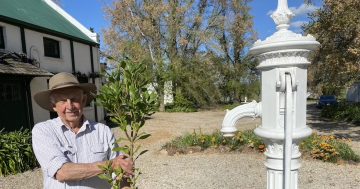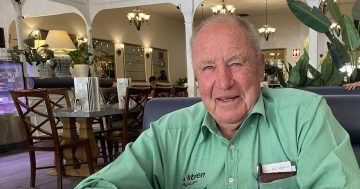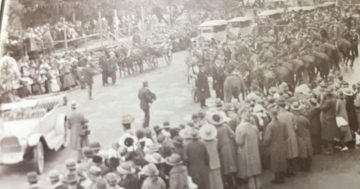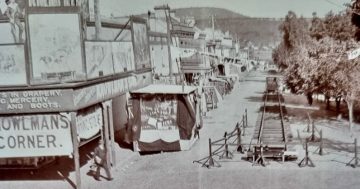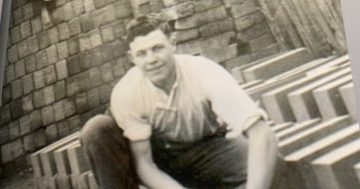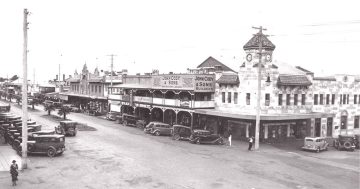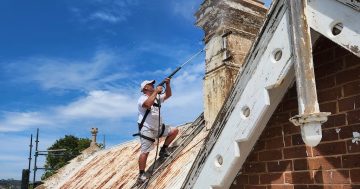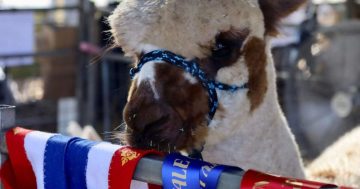
Roger Bayley looks over bound copies of newspapers at the History Goulburn Research Centre. Photo: John Thistleton.
Years after leaving an orphanage in Parramatta, Goulburn historian and author Roger Bayley discovered it had been founded by a slave trader.
His father Fred was a painter at the orphanage and his mother Grace helped clean in the laundry while Roger attended school there.
Run by the Presbyterian Church, Roger and the orphanage’s children filed past a portrait of the founder, Scotsman James Burns each Sunday to pay their respects.
“I found out many years later he was a slave trader and used the profits to build an orphanage,” Roger said.
Burns had been dealing in Pacific Islanders to work in Queensland’s sugar cane fields.
After his schooling and obtaining nursing qualifications in 1975, Roger began travelling.
“It started with wanting to find adventure and travel, digging for gold, finding ship wreck treasure, looking for bushrangers’ loot in caves,” he said.
Finding the caves and treasure required plenty of research.
In his 20s he set off travelling around Australia in Kombi vans or motor bikes, collecting information and great stories, stopping only when his money ran out. He’d find work, save some money and get back on the road again.
He once followed the Great Dividing Range, sticking to its spine for thousands of miles on fire trails and farm tracks. “That was a great adventure, it took me eight months, you could probably do it in three days now,” he said.
But his free and easy lifestyle stopped abruptly. “I ran out of money in Goulburn and just fell in love with the place.”
He’s lived in the historic city ever since.
Roger didn’t find his gold, but has developed skills for research and a nose for fresh angles on historic events. He also continues to read Australian authors Bill Beatty, Frank Clune and Ion Idriess.
He’s ferreted through newspaper offices, local historic societies and libraries. He’s scribbled notes over the pages of a tiny atlas of Australia and bought a bigger one with 156 maps. Now it’s his filing index. “I ended up with a mobile library until I virtually broke the springs on the Kombi. I was carrying too much weight.”
Roger’s kept all his files. He has about 86,000 on his computer and every room of his house is floor-to-ceiling with books.
Over time Roger’s writing has become more entertaining which he attributes to having drunk too much rum and telling too many stories around camp fires. His preferred style is fast-paced, sometimes over-the-top.
On the topic of stockmen from southern NSW forming the 1st Australian Horse Bridge he once wrote: “Some said they could shoot a fly off a rabbit’s nose while steering a horse through a hollow log at full gallop. At midnight.”
Roger’s written for specialist fossicking magazines, and the long-running Australasian Post. Hearing his local bush ranging tales at a barbecue years ago, the then Mayor of Goulburn Max Hadlow told Goulburn Post journalist Ray Williams who enlisted him as a regular newspaper contributor. These days he writes for History Goulburn’s quarterly bulletin.
He decided years ago to stop re-hashing other people’s work and find original sources from court and police records, diaries and journals. If all else fails, he goes to old newspapers. “I like to think I never write a story that hasn’t got new information in it,” he said.
He has long been drawn to the exploits of young men on stolen racehorses galloping through the bush under a hail of bullets from the police. He said bushrangers wreaking havoc across the district in the early 1800s played a pivotal role in Goulburn’s establishment.
Four land owners who had become magistrates wrote to the governor of the time, asking for a court house, jail and detachment of mounted police to be established in the County of Argyle.
The governor chose the confluence of two rivers to establish a garrison and supporting buildings. “I have the entire list of letters to the governor, from the governor to the surveyor general and surveyor general to the surveyor saying `go and map out a town’. We also have the maps from 1828.
“So that’s why Goulburn was established. It’s the only place I’m aware of that was established because of a bushranger and his gang. His name was John Tennant.
“We have our fourth jail now and we have the NSW Police Academy. We have a lot to thank bushrangers for.”
For Roger, researching and writing about them continues to offer the prospect of new discoveries.







